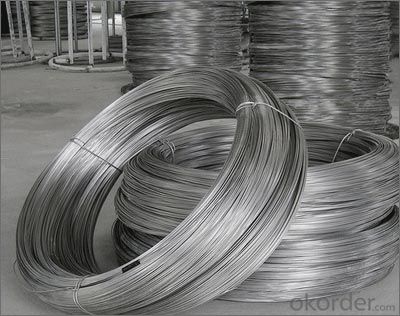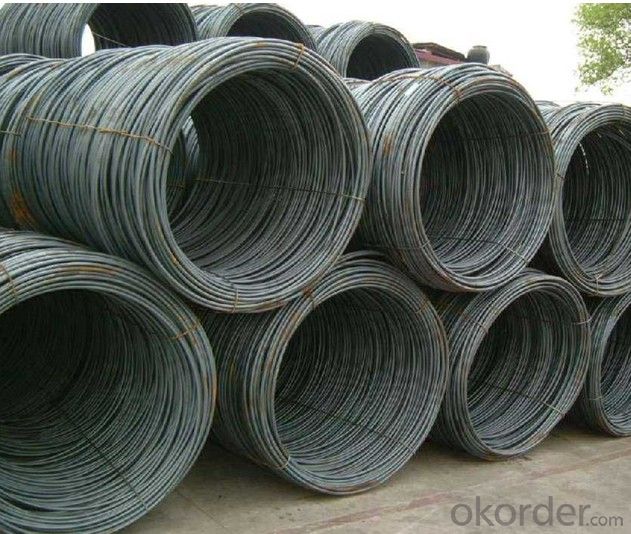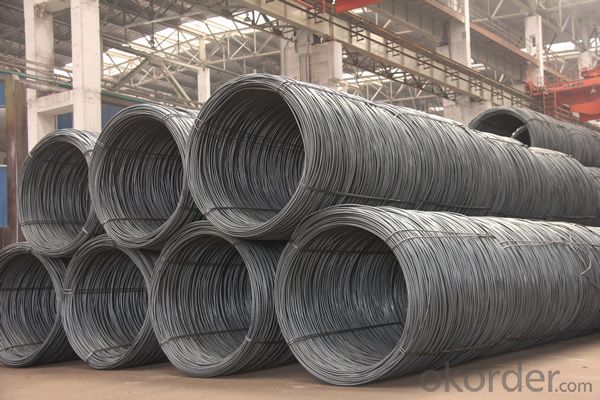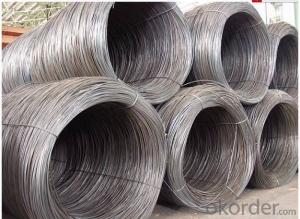Steel Wire Rods PVC Coated Steel Wire PVC Coated Rod Iron Wire
- Loading Port:
- Tianjin
- Payment Terms:
- TT or LC
- Min Order Qty:
- 25 m.t.
- Supply Capability:
- 30000 m.t./month
OKorder Service Pledge
OKorder Financial Service
You Might Also Like
Product Description of Steel Wire Rods PVC Coated Steel Wire PVC Coated Rod Iron Wire:
OKorder is offering Steel Wire Rods PVC Coated Steel Wire PVC Coated Rod Iron Wire at great prices with worldwide shipping. Our supplier is a world-class manufacturer of steel, with our products utilized the world over. OKorder annually supplies products to African, South American and Asian markets. We provide quotations within 24 hours of receiving an inquiry and guarantee competitive prices.
Product Applications of Steel Wire Rods PVC Coated Steel Wire PVC Coated Rod Iron Wire:
Steel Wire Rods PVC Coated Steel Wire PVC Coated Rod Iron Wire are ideal for structural applications and are widely used in construction and manufacturing. Carbon steel wire rod is mainly used for reinforcement of reinforced concrete and welded structure or reprocessed (roberts , nail, etc.) materials, especially used to produce wire drawing, welding electrode, nails, spring, electronic, precise machinery parts and so on.
Product Advantages of Steel Wire Rods PVC Coated Steel Wire PVC Coated Rod Iron Wire:
OKorder's Steel Wire Rods PVC Coated Steel Wire PVC Coated Rod Iron Wire are durable, strong, and wide variety of sizes. They are newly produced by good quality steel billets.
Main Product Features of Steel Wire Rods PVC Coated Steel Wire PVC Coated Rod Iron Wire:
· Premium quality
· Prompt delivery & seaworthy packing (30 days after receiving deposit)
· Can be recycled and reused
· Mill test certification
· Professional Service
· Competitive pricing
Product Specifications of Steel Wire Rods PVC Coated Steel Wire PVC Coated Rod Iron Wire:
Steel Grade: SAE1006-1018B
Standard: ASTM, GB
Diameter: 5.5mm, 6.5mm, 7mm,8mm,9mm,10mm,12mm,14mm
Type: in coil, coil weight around 2MT
Alloy or Not: Alloy
Technique: Hot Rolled
Place of Origin: China Mainland
Surface: round, no twisted, light and smooth
FAQ:
Q1: Why buy Hot Rolled Low Carbon Steel Wire Rods for Nails, Steel Wire Mesh from OKorder.com?
A1: All products offered byOKorder.com are carefully selected from China's most reliable manufacturing enterprises. Through its ISO certifications, OKorder.com adheres to the highest standards and a commitment to supply chain safety and customer satisfaction.
Q2: How do we guarantee the quality of our products?
A2: We have established an advanced quality management system which conducts strict quality tests at every step, from raw materials to the final product. At the same time, we provide extensive follow-up service assurances as required.
Q3: How soon can we receive the product after purchase?
A3: Within three days of placing an order, we will arrange production. The normal sizes with the normal grade can be produced within one month. The specific shipping date is dependent upon international and government factors, the delivery to international main port about 45-60days.
Packaging & Shipping
plastic film per bundle ,strapped with metal wire and then put into carton box .



- Q:What are the different alloys used in steel wire rod production?
- There are several different alloys used in steel wire rod production, including carbon steel, stainless steel, and alloy steel. Carbon steel is the most commonly used alloy and is known for its strength and durability. Stainless steel wire rods are highly corrosion-resistant and often used in applications where corrosion is a concern, such as in marine environments. Alloy steel wire rods are made by adding different alloying elements, such as chromium, nickel, or molybdenum, which enhance the mechanical properties of the wire rod, such as hardness, toughness, and heat resistance.
- Q:How is steel wire rod used in the manufacturing of wire shelves?
- Steel wire rod is used in the manufacturing of wire shelves as the primary material for the shelf structure. The wire rod is first processed into thin wires, which are then bent, shaped, and welded together to form the frame and mesh of the wire shelves. The high strength and durability of steel wire rod make it ideal for supporting and organizing various items on the shelves, ensuring stability and longevity.
- Q:What are the main factors influencing the choice of steel wire rod manufacturer?
- The choice of a steel wire rod manufacturer is influenced by several key factors. These factors encompass quality, price, reliability, production capacity, technical expertise, and environmental practices. Firstly, the quality of the product is a primary consideration for customers. They seek manufacturers that produce steel wire rods that meet their specific requirements and standards. Factors such as strength, durability, and consistency play a crucial role in this decision. Secondly, price is an important factor. Customers compare prices offered by different manufacturers to find the best value for their money. However, it is essential to consider price in relation to product quality and overall service provided by the manufacturer. Thirdly, reliability and reputation play a significant role in the decision-making process. Customers prefer manufacturers with a proven track record of consistently delivering high-quality products on time. Positive customer reviews and references from trusted sources greatly influence their choice. In addition, customers consider the production capacity and capabilities of a manufacturer. Depending on their specific needs, they may require a manufacturer that can produce large quantities of wire rods within a specified timeframe. Customization options and variations of the product may also be taken into account. Moreover, strong technical expertise and excellent customer support are valued by customers. Manufacturers that can provide technical guidance, assist with product development, and offer after-sales support are seen as valuable partners in the purchasing process. Lastly, environmental and sustainability practices have become increasingly important. Customers prioritize manufacturers that adopt sustainable production methods, minimize waste and emissions, and comply with environmental regulations. To summarize, the choice of a steel wire rod manufacturer is influenced by factors such as quality, price, reliability, production capacity, technical expertise, and environmental practices. Customers carefully evaluate these factors to ensure they select a manufacturer that can meet their specific requirements and provide a high-quality product and service.
- Q:How are steel wire rods used in the production of barbed wire for security fencing?
- Steel wire rods are a crucial component in the production of barbed wire for security fencing. These wire rods are used as the primary material to create the twisted and sharp barbs that provide deterrence and protection. The process begins with the steel wire rods being drawn through a series of dies, which reduces their diameter and increases their length. This process is known as wire drawing and helps to improve the strength and durability of the wire. Once the wire rods have been drawn, they are then twisted together to form a strong, continuous strand of wire. This twisted wire serves as the backbone of the barbed wire, providing stability and support. Next, the twisted wire is interwoven with sharp, pointed barbs. These barbs are created by cutting short lengths of the wire rods, sharpening the ends, and then attaching them to the twisted wire at regular intervals. The barbs are strategically placed and spaced to maximize the security and deterrent effect of the barbed wire. After the barbs have been attached, the barbed wire is typically galvanized to enhance its resistance to corrosion. The galvanization process involves coating the wire with a layer of zinc, which provides a protective barrier against rust and other environmental factors. This ensures that the barbed wire remains strong and effective in various weather conditions. Once the galvanized barbed wire has been produced, it can be wound onto spools or packaged in coils for ease of transportation and installation. The barbed wire is then ready to be installed as a security measure, typically on top of fences, walls, or other structures that require additional protection. Overall, steel wire rods play a vital role in the production of barbed wire for security fencing. They are transformed into twisted wire strands, which form the backbone of the barbed wire, and are then combined with sharp barbs to create a highly effective deterrent. The use of steel wire rods ensures that the barbed wire is strong, durable, and capable of withstanding harsh conditions, making it an essential component in security fencing systems.
- Q:How is steel wire rod used in the manufacturing of wire rope grilles?
- Steel wire rod is a crucial component in the manufacturing of wire rope grilles. It serves as the raw material that is drawn, twisted, and braided to form the wire rope structure. The high tensile strength and durability of steel wire rod make it ideal for creating strong and reliable wire ropes, which are then utilized in the construction of wire rope grilles for various applications like safety barriers, fencing, and architectural design.
- Q:How is the tensile strength of steel wire rod tested?
- The tensile strength of steel wire rod can be assessed through a method known as the tensile test or tension test. This test aims to ascertain the wire rod's ability to withstand tension by determining the maximum load or force it can endure without breaking. In the process of the tensile test, a representative sample of the steel wire rod is prepared through cutting it into a specific length. Subsequently, the sample is placed within a testing machine referred to as a tensile testing machine or universal testing machine. This machine comprises two jaws, one stationary and one movable, which securely grip the ends of the wire rod. Once the sample is suitably positioned in the testing machine, the movable jaw is gradually pulled away from the stationary jaw, exerting an increasing force on the wire rod. The machine gauges the force applied to the sample while simultaneously recording the resulting elongation or deformation of the wire rod. Throughout the duration of the test, the force and elongation are continuously monitored until the wire rod fractures. The maximum force applied just before the fracture is noted as the tensile strength of the steel wire rod. This value signifies the highest load or stress the wire rod can withstand without breaking. To ensure precise and dependable outcomes, multiple samples are typically tested to account for any variability in material properties. The average of these results is then considered as the representative tensile strength of the steel wire rod. In conclusion, the tensile strength of steel wire rod is determined through a controlled testing process utilizing a tensile testing machine. This machine measures the maximum force applied to the sample before it fractures, providing valuable insights into the material's strength and performance.
- Q:What are the different grain size measurement methods for steel wire rod?
- There are several different grain size measurement methods commonly used for steel wire rod. These methods provide important information about the microstructure and mechanical properties of the steel. One widely used method is the ASTM E112 standard, which involves the use of a microscope to measure the average grain size. This method requires preparing a metallographic sample, polishing it to a mirror-like finish, and etching it to reveal the grain boundaries. The sample is then examined under a microscope, and the grain boundaries are traced and counted to determine the average grain size. Another method is the Sieve Analysis method, which is commonly used for determining the grain size distribution in steel wire rod. In this method, a representative sample of the wire rod is sieved through a series of progressively smaller mesh sieves. The weight of material retained on each sieve is measured, and the grain size distribution is determined based on the percentage of material retained on each sieve. The Laser Diffraction method is another commonly used technique for measuring grain size in steel wire rod. In this method, a laser beam is directed through a suspension of the wire rod particles, and the scattering pattern is measured. The size of the particles can be determined based on the diffraction pattern, allowing for the calculation of the grain size distribution. Other methods include the Electron Backscatter Diffraction (EBSD) method, which uses an electron microscope to determine the crystallographic orientation and grain boundaries in the wire rod, and the X-ray Diffraction (XRD) method, which measures the angle of diffraction of X-rays to determine the crystallographic structure and grain size. Each of these grain size measurement methods has its advantages and limitations, and the choice of method depends on factors such as the desired level of accuracy, the type of steel wire rod being analyzed, and the available equipment and expertise.
- Q:What are the common production processes for actinium-coated steel wire rod?
- The common production processes for actinium-coated steel wire rod generally include wire drawing, cleaning, coating, curing, and packaging.
- Q:What are the different types of steel wire rod surface cleaning methods for wire galvanizing?
- There are several different types of steel wire rod surface cleaning methods for wire galvanizing. These include mechanical cleaning methods such as brushing or shot blasting, chemical cleaning methods such as pickling or acid cleaning, and electrolytic cleaning methods. Each method has its advantages and is chosen based on the specific requirements and conditions of the galvanizing process.
- Q:What are the main factors affecting the market alliances of steel wire rod?
- The main factors affecting the market alliances of steel wire rod include fluctuations in demand and supply, competitive landscape, pricing dynamics, government regulations and policies, technological advancements, and industry consolidation. Additionally, factors like raw material availability, transportation costs, and economic conditions can also play a significant role in shaping market alliances in the steel wire rod industry.
1. Manufacturer Overview |
|
|---|---|
| Location | |
| Year Established | |
| Annual Output Value | |
| Main Markets | |
| Company Certifications | |
2. Manufacturer Certificates |
|
|---|---|
| a) Certification Name | |
| Range | |
| Reference | |
| Validity Period | |
3. Manufacturer Capability |
|
|---|---|
| a)Trade Capacity | |
| Nearest Port | |
| Export Percentage | |
| No.of Employees in Trade Department | |
| Language Spoken: | |
| b)Factory Information | |
| Factory Size: | |
| No. of Production Lines | |
| Contract Manufacturing | |
| Product Price Range | |
Send your message to us
Steel Wire Rods PVC Coated Steel Wire PVC Coated Rod Iron Wire
- Loading Port:
- Tianjin
- Payment Terms:
- TT or LC
- Min Order Qty:
- 25 m.t.
- Supply Capability:
- 30000 m.t./month
OKorder Service Pledge
OKorder Financial Service
Similar products
New products
Hot products
Related keywords




























